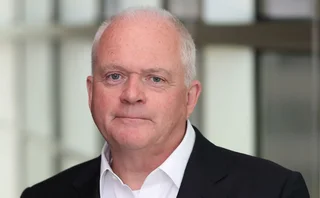
The novel structurer
As president of the nascent Structured Products Association, Keith Styrcula is striving to ensure the US market’s continued growth and development. By Navroz Patel

The concept of a US association first occurred to Styrcula in August 2003. In October, he approached Gautam Gujral of Credit Suisse First Boston (CSFB), Demetri Xistris of BNP Paribas and Steven Lofchie of law firm Davis Polk and Wardwell. Together, this quartet ultimately led the association’s first meeting. Its main focus is on developing best practices, something Styrcula believes is particularly timely given the growth in volumes and variety of products being offered in the US. For example, in 2003, 18 issuers listed a total of more than 100 products on the American Stock Exchange alone.
In addition to shaping dealers’ best practices, the association acts as a nexus of information on deals and innovation via a regular newsletter. “We want to present a cohesive voice for the structured products industry,” Styrcula says. But doesn’t this sound like the SPA may be encroaching on the International Swaps and Derivatives Association’s turf? He acknowledges that as membership grows there is the potential for tension with Isda, but stresses that the SPA is not a policy-setting group.
Serving as the SPA’s president is a pursuit for Styrcula in addition to his position as a director and senior financial structurer within the New York structured products group at SG, the investment banking arm of Société Générale. He joined SG in April 2003.
One of the determinants of success for any structured products business is an understanding of how best to capture the economics of a transaction via the legal structure of products, which is where Styrcula’s legal expertise comes in. While an attractive payout profile can wow a prospective investor, potential theoretical profits could prove difficult to realise unless the right structure – be that warrant, principal-protected product, trust or note – is chosen.
He began his career at CSFB in 1991, after graduating from Fordham Law School in New York. Styrcula had decided to focus on financial services and securities law five years earlier, when his father’s company, Food Craft – which owned a chain of convenience stores in Pennsylvania – became the object of a hostile takeover bid. The company’s successful fending off of the takeover became a cause célèbre in Pennsylvania, and was a catalyst for the state’s subsequent toughening up of its anti-takeover legislation.
Shortly after joining CSFB, the junior attorney’s boss left the legal group at the bank, leaving Styrcula as the only lawyer in New York handling CSFB’s growing derivatives-related business line. At the time, CSFB was at the vanguard of index arbitraging across US exchanges. Executing this strategy profitably, while abiding by exchange and SEC rules, was no mean feat.
In 1996, Styrcula joined SBC Warburg (which subsequently merged with UBS) as a director on the derivatives desk, reporting directly to the head of equity derivatives, David Purcell. Unlike his previous role – which was more of a control function – Styrcula was now very much in the front office, with the responsibility of developing cutting-edge legal and financial structures.
He then returned to CSFB in 1999. Hooked on structuring exotic deals, and convinced that structured products were destined to become bigger business, Styrcula played a pivotal role in developing an open-architecture investment platform for ultra-high-net-worth investors.
When CSFB bought stockbroker Donaldson, Lufkin and Jenrette (DLJ) for $11.5 billion in 2000, Styrcula was put in charge of developing an alternative structured product platform for DLJ’s private client services group. Starting from a zero-dollar business, CSFB executed $1.2 billion worth of hedge fund-linked and capital-guaranteed products during the first 15 months of the initiative. And Styrcula now believes the structured products market in the US is poised to grow significantly.
As if his work at SG and the SPA wasn’t enough, Styrcula is also a published writer (whose nom de plume is Stephen Rhodes). His 1997 financial thriller, The Velocity of Money, achieved critical and commercial success, but he says he’s not considering becoming a full-time fiction writer any time soon. “Working on the street brings you into contact with a diverse bunch of very smart people. To be honest, I wouldn’t want to lose that potential source of inspiration by not working there,” he says.
Only users who have a paid subscription or are part of a corporate subscription are able to print or copy content.
To access these options, along with all other subscription benefits, please contact info@risk.net or view our subscription options here: http://subscriptions.risk.net/subscribe
You are currently unable to print this content. Please contact info@risk.net to find out more.
You are currently unable to copy this content. Please contact info@risk.net to find out more.
Copyright Infopro Digital Limited. All rights reserved.
As outlined in our terms and conditions, https://www.infopro-digital.com/terms-and-conditions/subscriptions/ (point 2.4), printing is limited to a single copy.
If you would like to purchase additional rights please email info@risk.net
Copyright Infopro Digital Limited. All rights reserved.
You may share this content using our article tools. As outlined in our terms and conditions, https://www.infopro-digital.com/terms-and-conditions/subscriptions/ (clause 2.4), an Authorised User may only make one copy of the materials for their own personal use. You must also comply with the restrictions in clause 2.5.
If you would like to purchase additional rights please email info@risk.net
More on People
Robertson leaves Barclays’ prime services in New York
Head of prime derivatives services unit departs after seven years with the bank for Carbon Point
Citadel Securities hires former Eisler CRO
Pregnell joins market-maker after demise of hedge fund
People: Fishwick hands over BlackRock CRO role, Citi expands Asia FX team, and more
Latest job changes across the industry
Nomura shuffles risk methodology team
Epperlein takes advisory role six months after Japanese bank’s FRTB IMA go-live
Andy Ross leaves StanChart
CurveGlobal veteran confirms his departure as bank’s global head of prime brokerage
People: BofA’s new markets heads, Barclays takes SG’s Mastrangelo, and more
Latest job changes across the industry
People: BNY taps Nasdaq CRO for enterprise risk, Hoornweg steers StanChart CIB solo, and more
Latest job changes across the industry
People: Nomura’s rates rebuild continues, DB USA’s new CEO, and more
Latest job changes across the industry







